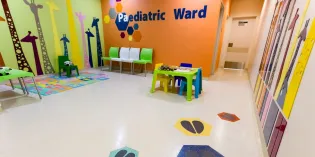For all details, download our full report and overview report below.
For a visual summary, you can see an overview of our recommendations and key findings.
Introduction
Demand on the paediatric workforce continues to escalate rapidly. Pandemic-driven staff shortages and increases of 30% in paediatric waiting lists1 2 3 4 5 have exacerbated a service already heavily strained due to increasing chronic disease, delivery of new treatment options and changes in neonatology care provision. This is in addition to significant increases in emergency department attendances, particularly in under 5s6 across the UK, unsurprisingly highest in the most deprived areas7 8 and which have led to double rotas and a shortage of consultant-led care8 .
At the time of the last College Workforce Census in 2017, paediatric workforce demand across the UK had outstripped capacity by 21%9 with a forecast need for 856 additional whole time equivalent (WTE) consultants8 . This need is only likely to increase in the current climate, compounded by increasing numbers of consultants and trainees moving toward less than full time working. In 2022, for example, we have 30% of trainees working less than full time with a projected increase to 60% by 2040; this is unlikely to be alleviated by current projected increases in trainee numbers7 10 . Furthermore, while increases in the number of general paediatricians has slowly risen, that of community paediatricians has declined by a third (forecast to halve by 2040 without intervention)11 .
Community health services have been especially impacted and the long-term effects of neonatal and developmental disorders are projected to increase alongside rising mental health and substance abuse issues in adolescents and young adults7 . Child poverty is escalating7 12 , with a surge in health inequality between those from wealthy and deprived areas12 , exacerbated by both the pandemic and the rising cost of living13 .
To cope with this changing landscape and to mitigate the potential doubling of emergency department and outpatient attendances over the next twenty years7 , changes in paediatric working are urgently needed. With some level of integrated care already present in Wales, Scotland and Northern Ireland, the establishment of this approach across primary and secondary healthcare, social services, education, voluntary sector and other essential components for the whole of the UK will be vital in preventing the strain on an already overextended paediatric workforce and in turn improving the quality of child healthcare7 .
About the Census
The RCPCH Workforce Census 2022 provides an overview of consultants and SAS doctors working in the UK. The Census was sent directly to College members for individual response in contrast to previous efforts where clinical leads/directors were asked to respond on behalf of their trusts/health boards. The Census was open for two and a half months with each recipient answering 20 questions via a dedicated microsite. Targeting individuals, the final number of respondents was 1,515 from across the ten NHS Regions (seven in England, Northern Ireland, Scotland and Wales); this is compared to 129 fully complete clinical lead/director responses for the 2017 Census14 . For 2022, the response rate was approximately 19%, which is comparable to the College Membership Survey, 202115 (as previous workforce Censuses were sent to clinical leads/ directors only, we cannot compare with previous Census response rates).
We analysed each of the key questions pertaining to primary job type, specialty, working pattern, programmed activities, on-call duties and retirement plans, plus demographic data provided equally from Census responses, from our College database and from equality, diversity and inclusion (EDI) data collected as part of a separate EDI survey in addition to the Membership Survey15 16 .
Recommendations
1. Each nation should develop a bespoke child health workforce strategy
NHSE/HEE, Health Education and Improvement in Wales (HEIW), Scottish Government, Convention of Scottish Local Authorities (COSLA) and NHS Education for Scotland (NES) and the Department of Health in Northern Ireland should continue to develop a bespoke child health workforce strategy with an integrated approach across the four nations. The plans should include transparent and independently verified projections of workforce supply and demand, and should cover the next five, ten, and twenty years, fully costed by governments across the UK.
Each strategy should:
- Respond to immediate needs and financial pressures and take into account new and emerging models of care to deliver robust professional service standards. Furthermore, the plans should consider future and growing children and young people (CYP) need.
- Be based on robust data and modelling of future trends, eg growing less than full time working, which should be collected on a national and local level so that there is better insight of workforce pressures and tackle the healthcare workforce staff shortages to deliver the best care for children throughout the country.
- Develop a multi-disciplinary workforce in all parts of the UK including remote, rural, and large urban areas and take a whole system approach that considers sustainable working of advanced clinical practitioners, doctors, physician associates, nurses, health visitors, allied health professionals, and support roles across community, mental health, schools, education and hospitals.
- Consult children and young people on what they would like the workforce to look like and the knowledge and skills they require to deliver a safe and sustainable, high-quality service.
2. NHS organisations and senior leaders should support the wellbeing of the child health workforce and modern ways of working
NHS organisations and senior leaders should support staff to work in the pattern they want to and improve their health, wellbeing, and work-life balance. This should include:
- Protecting staff from burnout by ensuring that all staff take annual leave, necessary breaks, and that they have access to health and wellbeing support when needed.
- Engaging with staff to develop an inclusive and caring environment so that staff are happy in the workplace, quality of service is improved, and patients are safe.
- Employers looking positively on requests for less than full time training and job sharing, in line with modern ways of working including flexible employment models.
- Better understanding of the workplace culture profile and demographics and identifying the reasons why staff leave, and the development opportunities that might have encouraged them to stay. This should include urgent reform of the pension tax rules that are punishing doctors for working extra shifts.
3. NHS organisations and senior leaders should ensure equality, diversity and inclusion are integral to workforce planning
NHS organisations and senior leaders should:
- Set up equality, diversity and inclusion initiatives and groups to ensure the workforce and leadership reflects the diversity of the population that it serves.
- Support a diverse workforce by establishing inclusive working models for all including those who have neurodiversity and accessibility needs and reduce barriers to developing their careers.
- Ensure EDI processes are monitored and measured for success so that equal opportunities, fair recruitment and development processes are available for all.
- Provide training on the importance of diversity and recognising unconscious bias.
Key findings
Open to see our interactive graphs.
- Demographics
-
The majority of respondents were female, with average paediatrician age between late 40s and early 50s.
- Consultants and SAS doctors
-
Almost 90% of respondents were consultants, with the remainder SAS doctors. SAS doctors tended to be female and slightly younger.
- Primary job type and sub-specialty
-
Primary job type was roughly split between generalists (42%) and specialists (37%) with almost a fifth of the sample community paediatricians. Community paediatricians tended to be older and were more likely female, while specialists were more likely male. In terms of sub-specialties, the most common were neonatology, community child health and diabetes and endocrinology.
- Contract and working pattern
-
Almost 90% of respondents were on permanent contracts, with 70% working full time. Those working less than full time were more likely to be female and younger. Compared to all other sub-specialties, more community paediatricians worked less than full time than full time.
- Programmed Activities (PA)
-
The average number of PAs exceeded the recommended 10. Direct clinical care PAs were on average seven weekly, with supporting professional activities 1.7 - considerably lower than recommended weekly average of 2.5.
- On-call
-
Among our respondents, 62% performed on-call duties. The majority of these were specialist paediatricians, in particular those working in metabolic disorders, nephrology, cardiology and oncology. Most respondents were working between 1:6 and 1:10 on call, but 23% were working on-call 1:5.
- Retirement
-
The majority of respondents predicted that they would retire between 60 and 64 years, with women more likely to retire at a younger age. Over half of the sample were unsure if they would return to work for the NHS post-retirement, while 30% said that they would not; male paediatricians were more likely to return to work.
- Equality, Diversity and Inclusion (Census and Membership Survey)
-
Over half of the respondents classified themselves as English/Welsh/Scottish/ Northern Irish/British, while just over 40% identified as Christian. A third of respondents had a disability, but three-quarters did not see any corresponding barriers or limitations. Child carers were relatively split across the sample, with no sex bias; adult carers however, comprised 25% of the sample, most of whom were female and working less than full time.
Conclusion
The pressure of the COVID-19 pandemic upon an already stretched workforce, has exposed concerns while exacerbating existing issues. Paediatric and child health services were affected by a number of factors including redeployment of staff and space, cancellation of outpatient clinics, and concerns with relation to staff wellbeing, with additional staff absence due to stress and heightened anxiety about safety, especially in higher-risk groups such as Black, Asian and minority ethnic (BAME) staff.
Inadequate workforce planning, funding, and failure to expand healthcare professional numbers in line with population need poses a real threat to the delivery of flexibility for paediatricians.
Employers should tackle the ongoing attrition, retention, and early retirement concerns including developing a retention strategy, using data and diagnostics to understand the workplace culture profile and demographics and identifying areas of high turnover and the reasons for leaving. It is highly important that equality, diversity and inclusion initiatives are established and embedded in the workforce, with no room for discrimination.
It is crucial that the workforce is appropriately supported, accounting for the wellbeing of staff, changes in working patterns and new ways of working to ensure delivery of quality care and improving child health outcomes.
Contributors
We would like to thank all respondents who submitted invaluable information to the RCPCH Workforce Census 2022.
This work was led by the RCPCH Workforce Information team: Nawsheen Boodhun (Head of Workforce Information), Sarah Gregory (Project Manager) and Davide Carzedda (Analyst) with the support of the RCPCH Officer for Workforce Planning and Health Services, Dr Nicola Jay. Many thanks to Emily Arkell (Director of Research & Quality Improvement), Daniel Waeland (Director of Education & Training), and our colleagues from across the College who provided feedback on the report.
- 1Paediatricians call on government to take action as children’s waiting lists soar to 350,000 for the first time [press release]. 2022.
- 2NHS Confederation. Hidden waits: the lasting impact of the pandemic on children’s services in the community. 2022.
- 3Northern Ireland Commissioner for Children and Young People. More Than A Number: A Rights Based Review of Health Waiting Lists in Northern Ireland. 2021.
- 4Royal College of Paediatrics and Child Health. RCPCH responds to Nuffield Trust report on impact of the pandemic on children and young people. 2022.
- 5Government WA. gov.wales/transforming-and-modernising-planned-care-and-reducing-waiting-lists. 2022.
- 6Royal College of General Paediatrics. RCPCH comments on reports of increased admissions of under 5s in hospital with COVID-19 2022 [Available from: www.rcpch.ac.uk/news-events/news/rcpch-comments-reports-increased-admissions-under-5s-hospital-covid-19.
- 7 a b c d e f Royal College of Paediatrics and Child Health. Paediatrics 2040 [Available from: https://www.rcpch.ac.uk/work-we-do/paediatrics-2040.
- 8 a b c Royal College of Paediatrics and Child Health. RCPCH Election Workforce Manifesto. 2019.
- 9Royal College of Paediatrics and Child Health. 2017 Workforce Census Overview. 2019.
- 10Academy of Medical Royal Colleges. Workforce: recruitment, training and retention in health and social care Inquiry. Academy Trainee Doctors’ Group response. 2022.
- 11Royal College of Paediatrics and Child Health, British Association for Community Child Health. Covering all bases, UK survey of community child health services 2016: Results. 2017.
- 12 a b Royal College of Paediatrics and Child Health. State of Child Health Report 2017. 2017.
- 13Royal College of Paediatrics and Child Health. RCPCH comments on polling showing cost of living crisis has made health worse 2022 [Available from: www.rcpch.ac.uk/news-events/news/rcpch-comments-polling-showing-cost-living-crisis-has-made-health-worse.
- 14Royal College of Paediatrics and Child Health. Workforce census 2017 resources 2019 [Available from: www.rcpch.ac.uk/resources/workforce-census-2017-resources.
- 15 a b Royal College of Paediatrics and Child Health. RCPCH Member survey 2021 - findings. 2022.
- 16Royal College of Paediatrics and Child Health. RCPCH and equality, diversity and inclusion (EDI) - Working for change. 2022.










